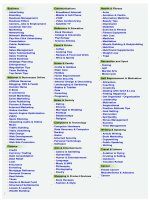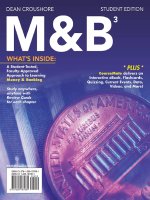Money and Banking: Lecture 2
Bạn đang xem bản rút gọn của tài liệu. Xem và tải ngay bản đầy đủ của tài liệu tại đây (154.46 KB, 25 trang )
Money and
Banking
Lecture 02
Review of the Previous Lecture
•
Five Parts of the Financial System
•
•
•
•
•
Money
Financial Instruments
Financial Markets
Financial Institutions
Central Banks
2-2
Topics under Discussion
• Five Core Principles of Money and Banking
•
•
•
•
•
Time has Value
Risk Requires Compensation
Information is the basis for decisions
Markets set prices and allocate resources
Stability improves welfare
• Financial System Promotes Economic Efficiency
• Facilitate Payments
• Channel Funds From Savers to Borrowers
• Enable Risk Sharing
2-3
Topics under Discussion
• Money
• Characteristics of Money
• Liquidity
2-4
Five Core Principles of Money and
Banking
1.
Time has Value
• Time affects the value of financial
instruments.
• Interest payments exist because of time
properties of financial instruments
2-5
Five Core Principles of Money and
Banking
1. Time has Value
• Example
• At 6% interest rate, 4 year loan of $10,000 for
a car
• Requires 48 monthly installments of $235
each
• Total repayment = $235 x 48 = $11,280
•
$11,280
>
$10,000
(total repayment)
(amount of loan)
• Reason: you are compensating the lender for the
time during which you use the funds
2-6
Five Core Principles of Money and
Banking
2.
Risk Requires Compensation
• In a world of uncertainty, individuals will
accept risk only if they are compensated in
some form.
• The world is filled with uncertainty; some
possibilities are welcome and some are not
2-7
Five Core Principles of Money and
Banking
2.
Risk Requires Compensation
• To deal effectively with risk we must consider
the full range of possibilities:
• eliminate some risks,
• reduce others,
• pay someone else to assume particularly onerous
risks, and
• just live with what’s left
• Investors must be paid to assume risk, and
the higher the risk the higher the required
payment
2-8
Five Core Principles of Money and
Banking
2.
Risk Requires Compensation
• Car insurance is an example of paying for
someone else to shoulder a risk you don’t
want to take. Both parties to the transaction
benefit
• Drivers are sure of compensation in the event of
an accident
• The insurance companies make profit by pooling
the insurance premiums and investing them
• Now we can understand the valuation of a
broad set of financial instruments
• E.g., lenders charge higher rates if there is a
chance the borrower will not repay.
2-9
Five Core Principles of Money and
Banking
3.
Information is the basis for decisions
• We collect information before making
decisions
• The more important the decision the more
information we collect
• The collection and processing of information
is the basis of foundation of the financial
system.
2-10
Five Core Principles of Money and
Banking
3.
Information is the basis for decisions
• Some transactions are arranged so that
information is NOT needed
• stock exchanges are organized to eliminate the
need for costly information gathering and thus
facilitate the exchange of securities
• One way or another, information is the key to
the financial system
2-11
Five Core Principles of Money and
Banking
4.
Markets set prices and allocate resources
• Markets are the core of the economic system;
the place, physical or virtual,
• Where buyers and sellers meet
• where firms go to issue stocks and bonds,
• where individuals go to purchase assets
• Financial markets are essential to the economy,
• channeling its resources
• minimizing the cost of gathering information
• making transactions
2-12
Five Core Principles of Money and
Banking
4.
Markets set prices and allocate resources
• Well-developed financial markets are a
necessary precondition for healthy economic
growth
• The role of setting prices and allocation of
resources makes the markets vital sources of
information
• Markets provide the basis for the allocation of
capital by attaching prices to different stocks or
bonds
2-13
Five Core Principles of Money and
Banking
4.
Markets set prices and allocate resources
• Financial markets require rules to operate
properly and authorities to police them
• The role of the govt. is to ensure investor
protection
• Investor will only participate if they perceive the
markets are fair
2-14
Five Core Principles of Money and
Banking
5.
Stability improves welfare
• To reduce risk, the volatility must be reduced
• Govt. policymakers play pivotal role in
reducing some risks
• A stable economy reduces risk and improves
everyone's welfare.
• By stabilizing the economy as a whole monetary
policymakers eliminate risks that individuals can’t
and so improve everyone’s welfare in the process.
2-15
Five Core Principles of Money and
Banking
5.
Stability improves welfare
• Stabilizing the economy is the primary
function of central banks
• A stable economy grows faster than an
unstable one
2-16
Financial System Promotes
Economic Efficiency
•
The Financial System Makes it Easier to
Trade
1. Facilitate Payments - bank checking
accounts
2. Channel Funds from Savers to Borrowers
3. Enable Risk Sharing - Classic examples are
insurance and forward markets
2-17
Financial System Promotes
Economic Efficiency
• 1. Facilitate Payments
• Cash transactions (Trade “value for value”).
Could hold a lot of cash on hand to pay for
things
• Financial intermediaries provide checking
accounts, credit cards, debit cards, ATMs
• Make transactions easier.
2-18
Financial System Promotes
Economic Efficiency
• 2. Channel Funds From Savers to Borrowers
• Lending is a form of trade ( Trade “value for a
promise”)
• Give up purchasing power today in exchange for
purchasing power in the future.
• Savers: have more funds than they currently
need; would like to earn capital income
• Borrowers: need more funds than they currently
have; willing and able to repay with interest in the
future.
2-19
Financial System Promotes
Economic Efficiency
• 2. Channel Funds From Savers to Borrowers
• Why is this important?
• A) Allows those without funds to exploit profitable
investment opportunities.
• Commercial loans to growing businesses;
• Venture capital;
• Student loans (investment in human capital);
• Investment in physical capital and new
products/processes to promote economic growth.
2-20
Financial System Promotes
Economic Efficiency
• 2. Channel Funds From Savers to Borrowers
• Why is this important?
• B) Financial System allows the timing of income and
expenditures to be decoupled.
• Household earning potential starts low, grows
rapidly until the mid 50s, then declines with age.
• Financial system allows households to borrow
when young to prop up consumption (house loans,
car loans), repay and then accumulate wealth
during middle age, then live off wealth during
retirement.
2-21
Financial System Promotes
Economic Efficiency
$
Consumption
Savings
Dissavings
Dissavings
Income
Retirement
Begins
Time
2-22
Financial System Promotes
Economic Efficiency
• 3. Enable Risk Sharing
• The world is an uncertain place. The financial
system allows trade in risk. (Trade “value for a
promise”)
• Two principal forms of trade in risk are
insurance and forward contracts.
• Suppose everyone has a 1/1000 chance of dying
by age 40 and one would need $1 million to
replace lost income to provide for their family.
• What are your options to address this risk ?
2-23
Summary
• Five Core Principles of Money and Banking
•
•
•
•
•
Time has Value
Risk Requires Compensation
Information is the basis for decisions
Markets set prices and allocate resources
Stability improves welfare
• Financial System Promotes Economic Efficiency
• Facilitate Payments
• Channel Funds From Savers to Borrowers
• Enable Risk Sharing
2-24
Upcoming Topics
• Money
• Characteristics of Money
• Liquidity
• Payment system
• Commodity vs. Fiat Money
• Cheques
• Other forms of payments
• Future of Money
• Measuring Money
• Financial Instruments
• Uses
• Characteristics
• Valuation
• Financial Markets
• Role & Structure
2-25









